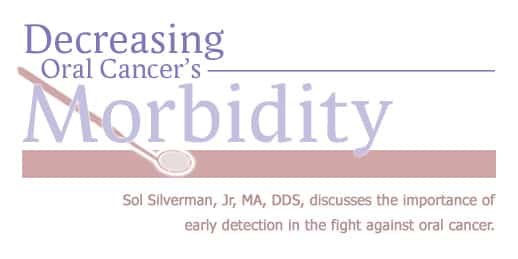
Decreasing Oral Cancer’s Morbidity
Sol Silverman, Jr, MA, DDS, discusses the importance of early detection in the fight against oral cancer.
Q. How high is the incidence of oral cancer?
A. There are about 31,000 new oral and pharyngeal cancers diagnosed each year in the United States and approximately 9,000 deaths.1 The most dire statistic is that once a person is diagnosed with oral cancer and treated, the overall 5-year survival rate is only about 58%.1 In spite of the many advancements in surgery, radiation, and chemotherapy, the 5-year survival rate has not improved substantially over the past 2 decades.
The key is early detection. When patients are typically diagnosed with oral or pharyngeal cancer, about two thirds of the cases are advanced.2 Because of the advanced status, many patients die from the disease and those who survive the aggressive treatment often have a dramatic reduction in quality of life. The most important move we can make today to decrease oral cancer’s morbidity is earlier diagnosis.
Q. What constitutes early detection?
A. We usually define early detection as a localized lesion in the oral and pharyngeal area where the largest diameter of the lesion does not exceed 1.5 inches (3 cm) and there is no evidence of it spreading into the neck. If a lesion is found at this stage, the 5-year survival rate exceeds 80%.1
Q. What are the main risk factors for oral cancer?
A. Cancer is a multifactorial disease. While genes are critically important, other factors play a role, some of which we’ve identified, others we haven’t. Certainly smoking and alcohol independently increase the risk. When used together, this further increases the risk. So these are controllable factors that we focus on in educating the public. Other factors include diet, viruses, and aging.
Q. What is the role of the dental hygienist in early detection of oral cancer?
A. Early detection also includes premalignant lesions that are usually white (leukoplakia). Microscopic dysplasia of epithelial cells that line the mouth further increases the risk for malignant transformation. These white lesions may have a red component (erythroleukoplakia) that further increases the risk for cancer or dysplasia. Leukoplakic lesions may or may not be symptomatic. Dental hygienists are key in the early detection of oral cancer because they see most patients, they establish rapport, and they perform most initial oral examinations. During oral examinations, the hygienist is looking for some deviation from normal. Sometimes the patient has a complaint that can be focused on. But particularly when it’s an early lesion, the patient may not even be aware of it. The hygienist is the first line of defense here. He or she can notify the dentist in the practice and/or make a referral to a designated office/clinician with experience in oral cancer detection and diagnosis.
Q. What are the most effective screening procedures?
A. First of all, I believe that patients should know that when the oral examination is being performed, hygienists are not only looking for caries and periodontitis, but that they are also doing an oral cancer examination. The hygienist can explain that he or she is looking for any change—a red spot, a white spot, a red and white spot, an ulcer, etc. Patients should be aware that cancer can occur in the oral pharyngeal area, and that is why any change in the area indicates a possible problem and must be evaluated. Any lesion that disappears is not cancer or precancer.
Patient history is also an important part of the oral examination. The patient may complain of a lump or some other oddity that can provide a good starting place for the visual examination. The next strategy is to use a screening tool to see if there is any deviation from normal. Any procedure that helps identify a deviation from normal is an adjunctive technique. Approved adjunctive techniques include brush biopsy, toluidine blue staining, and chemiluminescence. These approaches help identify abnormalities, thus accelerating the biopsy or at least referral for further evaluation. A wide array of continuing education courses are available on using adjunctive techniques in detecting oral cancer and I highly recommend that dental health care providers become well-versed in their practice.
REFERENCES
- Jemal A, Siegel R, Ward E, et al. Cancer statistics, 2006. CA Cancer J Clin. 2006;56:106-130.
- Silverman S. Oral Cancer. 5th ed. Hamilton, Ontario: BC Decker; 2003.
From Dimensions of Dental Hygiene. June 2006;4(6): 26.

